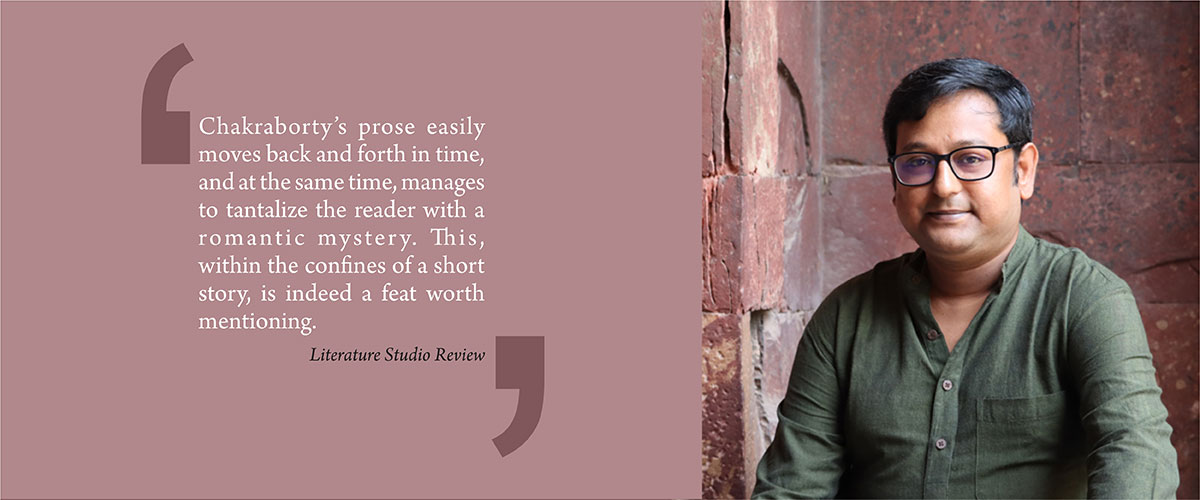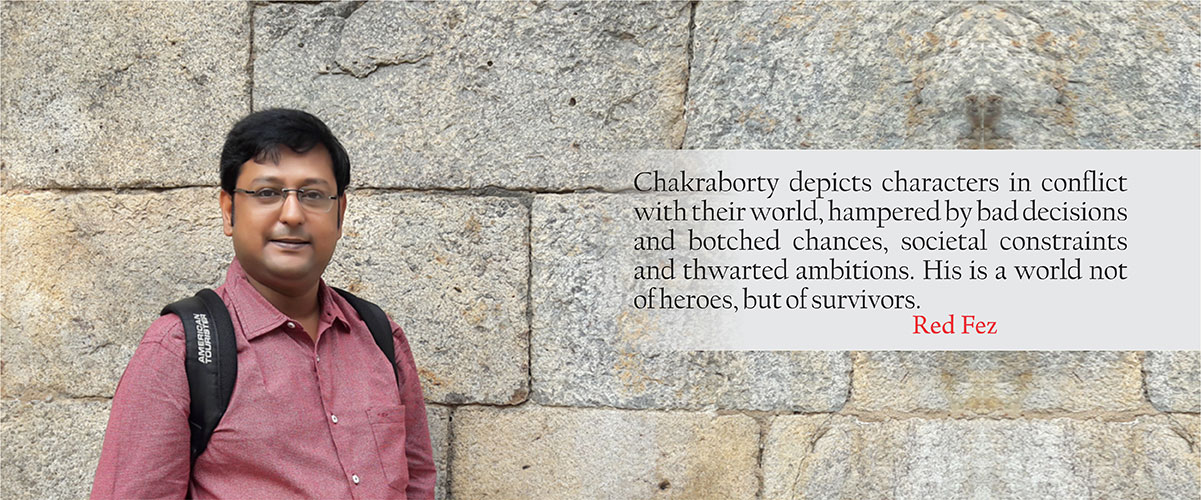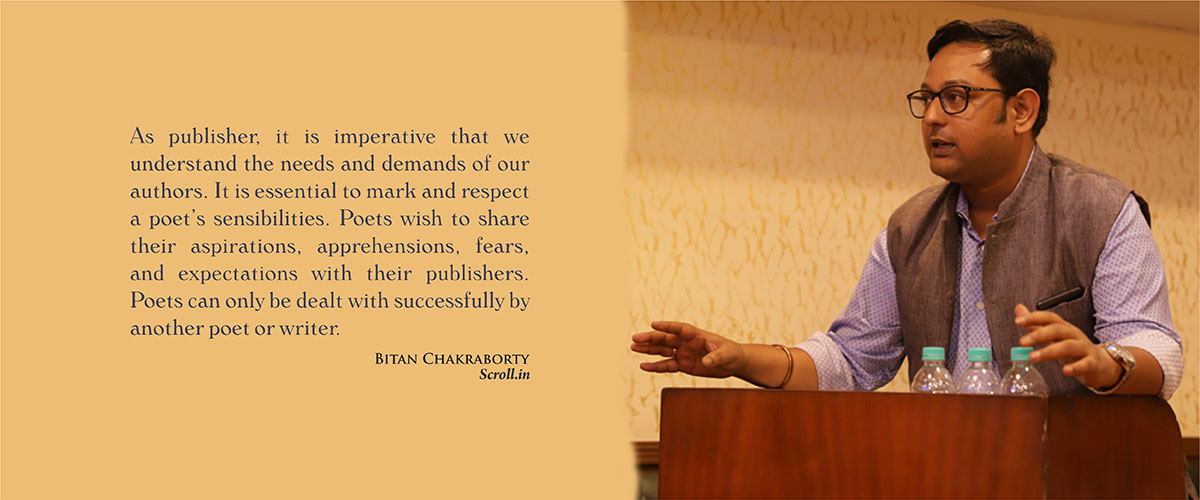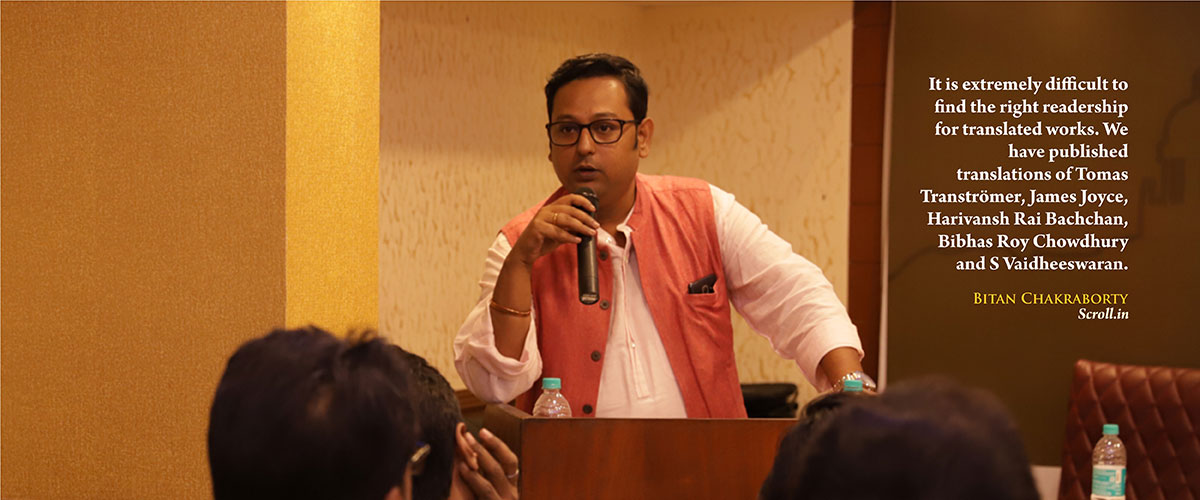Reviews
Chakraborty’s marvellous stories present us with a conundrum of lasting importance. In certain ways, such stories aid us in aligning ourselves with more humane goals and social structures. This collection of eight short stories aims to suggest how we can traverse the era with grace. Even if a reader is not sympathetic to the political economy of the author, the stories are brilliant and lead readers to reflect on modern conditions.
The Statesman. Read full review here.
The modernistic slant of the collection is expressed with objectivity without authorial interventions and, consequently, the lack of any judgemental attitude. Yet, Chakraborty successfully suggests there is no law and order, justice or tolerance in contemporary society, only a wide chasm between the haves and the have-nots, which is aggravated with every passing day as he repeatedly portrays ordinary people as having no rights, voice or means to fight the corrupt.
Borderless. Read full review here.
In practically every story, there is a narrative of human greed that has gone awry; of innocence corrupted by the real world; of the inability of the human being, usually all male in this collection of stories, to retain idealism and incorruptibility. Darkness and death, politics and the stone chip business, the losing of youthful idealism to a life of pure self-interest and ruthlessness, and a pursuit of culture that ends in the loss of youthful ideals to political exigency are some of the strains that run through Chakraborty’s fiction.
Cafe Dissensus. Read full review here.
Finally, where does the ‘Blight’ emanate from, the book seems to ask. Poverty and destitution carved into an unequal polity? The destruction of arable land and family hutments by profit-mongering ‘developers’? The breakdown of ethics due to political arm-twisting? The historical incapacity of women to be anything but receivers of such violence? Bitan Chakraborty is our modern-day truth-teller, unflinchingly pulling away all pretences of a resurgent India. Vivid, insightful and brilliant, this book has gripping stories with incipient messages.
The Book Review (June 2024). Read full review here.
The novella thus suggests not an imminent arrival of dystopia, but highlights something that is embedded within us. To fear the imminent danger of something invisible to us is absurd and is like avoiding the present danger that is engulfing us. Chakraborty’s approach most reminds of Franz Kafka’s “The Great Wall of China” (1930), in which he writes people who are indifferent toward their problems, and are busy building a wall in order to protect themselves from a faraway enemy that might intrude some time, somewhere—in the near future.
Strange Horizons. Read full review here.
After reading this novel, the salesman in a shop will never seem faceless, or the lad at a lottery booth appear to be a ruffian. Chakraborty has the uncanny knack of humanizing the marginal people who arrive at the ‘city of hope’ (if not joy) and following them through the tragi-comedy of survival. As one character says, ‘It’s easy to come to this city; but difficult to stay on.’
The Book Review. Read full review here.
In a capitalist-competitive world order where one struggles for a square meal, one loses either companionship or their sense of moral judgement. Sometimes, both. Chakraborty, within the limited scope of a novella, explores both, alongside other issues. In his representation of a single person’s failure to withstand the city’s demands, he makes a case for ordinary Indians’ right to equality and better quality of life.
Outlook. Read full review here.
In Redundant, it is through the eyes of Kanak and Shubho that the city takes on different façades. The city of Kolkata turns into a repository of secrets. There are silences and gaps, and at times there are voices that stem from its bowels screaming.
The Wire.
The author also scatters hopeful aphorisms within the narrative. For instance, “there’s just a bridge of time between good and bad times” (p. 57). Shubho recalls being told in school. However, it seems the narrative does not support this tone of advice. Further, we read, “Compassion doesn’t sell in the city” (p. 48). Chakraborty is a realist. Perhaps with a hint of irony, a pharmacist notes that he will not discount his merchandise because he does not sell “fake medicines” (p. 59).
Counter Currents. Read full review here.
Chakraborty’s novel talks about the anxieties, depression, and helplessness of two young men caught in the rush of city life. By talking about their everyday struggles and their sporadic moments of success in their otherwise doomed lives, Chakraborty brings to the fore a tribe of economically marginalized individuals for whom day-to-day survival becomes a challenge.
Cafe Dissensus. Read full review here
It is interesting, that although there is no light at the end of the tunnel for most of his protagonists, no redeeming feature of the city that he offers up, yet one does not emerge from the book with any sense of doom. It is as if the characters have come to terms with their reality. The author frequently draws a contrast between the harshness of the environment and the sensitivity of the protagonist.
The Book Review. Read full review here
বিতান আনখশীর একজন রাজনৈতিক ব্যক্তিত্ব। কোনো দলীয় রাজনীতিতে বিতান যুক্ত নয় বলেই জানি। কিন্তু ওর শব্দ, বর্ণ, যতি সব যেন এক আবহমানের অসাম্যের প্রতি তীব্র শ্লেষ ছুড়ে দেয়। আমাদের আয়নার সামনে দাঁড় করায়। আমরা আমাদের মুখ লুকোবার চেষ্টা করি। এক তীব্র অস্বস্তিতে পড়তে হয় পাঠককে। মনে হয়, বিতান আমাকে উদ্দেশ্য করেই লেখেনি তো! আমরা যারা নন্দন চত্বরে যাই, কবিতা পড়ি, একাডেমিতে নাটক দেখি প্রতিবাদের, প্রতিরোধের এক কাল্পনিক সাম্য শান্তি ঐক্যের পৃথিবীর অথচ আমরা এই প্রসেনিয়ামের বাইরে এসে পরে ফেলি রংবেরঙের মুখোশ!
অপরজন। সম্পূর্ণ আলোচনা পড়ুন
“শিল্পান্তর” সিনেমাটির কথা মনে পড়তে থাকে যেখানে কাঁচা মুরগি রোজ খেতে খেতে অভ্যস্ত মানুষটি একদিন নিজের হাত নিজেই কামড়ে কামড়ে খেয়ে নিচ্ছিল। এই ভয়াবহ ইঙ্গিত ও প্রতীকধর্মী জাদুবাস্তবতায় উপন্যাসটি শেষ হয়। উল্লেখ্য এর অসাধারণ প্রচ্ছদটি কিন্তু সেই জগন্নাথের, যে দেবতা এবং ঠুঁটো। শুভ আসলে এক নায়ক, যার নামার্থ ‘ভালো’, সে-ই অমৃতের সন্তান কিন্তু মৃত্যুপথযাত্রী, কর্মসন্ধানী অথচ কর্মহীন। এ-উপন্যাস তাই আজকের জগন্নাথদের ঠুঁটো হওয়ার গল্প। আর বিতান সেই কারিগর যে মাঝপথে মূর্তি বানানো ফেলে চলে যায়, আর পাঠকেরা বাকিটুকু ভেবে আতঙ্কিত হয়। হতেই থাকে, হতেই থাকে…
আবহমান। সম্পূর্ণ আলোচনা পড়ুন।
Every detail is credible, anchored in the mundane reality of city-dwellers in urban metropolises in contemporary India. Chakraborty is not a fantasist or fabulist; reality is an unvarying constant in his stories. Pritha and Kamal, Chhanda and Bikash, all have to confront the harshness of reality—and the harshness is of an even monochrome, a hard and unvarying glare—virtually unrelieved by tenderness, as in a Mrinal Sen film. One has perforce to live with the situation; women do not want you if you are “handicapped” in any way, not even prostitutes; the nexus of politicians and realtors will evict the poor and the helpless in a ruthless quest for money-making; in a prevailing scenario of joblessness one has to survive by giving private tutoring. Reality is inescapable, unvarying, almost unending. Even if one wishes to escape from it in some fantastic utopia, like Arpan, with the gentle radiance of his artificial lamps in his garden, one cannot do so. Reality inevitably impinges on us. Where is la dolce vita? The question is purely rhetorical.
World Literature Today. Read full review here.
It is this return to innocence, an awakening of daylight after darkness, a regeneration after the apocalypse that gives a little hope in Chakraborty’s stories. No doubt there is darkness around and people are forced to be silent, they still breathe. There is hope in every breath. One can hope for magic realism, one can hope for post humanism, one can hope for a blue orange. Bitan Chakraborty has given us just that.
Kitaab. Read full review here.
Reading Bitan Charkraborty, I felt like I was seeing a world I knew was there but had never explored. I felt like a spy in a strange land. It was exciting as well as heartbreaking. His characters are often unpleasant people, unhappy to read about or imagine being, but through the pain, you gain an understanding.
Red Fez (Issue 133).
Whether it is Lali “writhing in pain” or Fatik “trying to save some domestic goods from [a] flattened house” in the story ‘Lost’ — or it is Pritha readying to get off as “the train slows down before pulling into Sealdah station” in the ‘Broken Moon’ — Chakraborty paints his scenes and constructs his characters with an authentic sense of conviction, evoking the ordinariness of the everyday.
The Asian Age. Read full review here.
Life is a spectrum of contrasting colors and feelings, of blacks & whites, of light and darkness, and the art of opposites is a necessary mechanism which refines the sensibilities of an artist to arrive at a realization, so aptly demonstrated by Chakraborty throughout the little palm sized paperback monograph. The readers find themselves pretty much positioned in a voyeuristic set up like in Hopper’s Night Window as Chakraborty elucidates on Kolkata group theater aesthetics. At the same time he also presents his psychological & intellectual marginality & terminality, like Hopper draws a picture of his own sense of isolation besides the lady across the window. Necessary questions, wonderful shared realizations, grotesque yet impressionist.
Theatre Street Journal (March, 2019). Read full review here.
Mr. Chakraborty writes not about the elites of India’s society, not about the beautiful people of Bollywood fantasies. He brings to life the small and all too ordinary tales of common people. His characters are not always likeable but always real to life. We know them. We can identify with them. They move through a world where everyone else is also struggling to get by. Everyone is grubbing and grasping. Everyone is on the fiddle; everyone is extending a palm to be greased.
Red Fez Magazine (Issue 90). Read full review here.
The city is not just an independent entity; it mirrors the inhabitants and reflects their emotions. Chakraborty expertly weaves the city into the story and the effect is seamless. Though the reader will definitely notice the part the city plays in Bougainvillea and Other Stories, these glimpses don’t feel deliberate, and therefore, Chakraborty gracefully avoids one of the biggest stumbling blocks that the short story writers trip on these days. Each sentence, each sight earns its place in the story. Many characters, like the unemployed youth Sanjeeb, or the frustrated contractor Rwitabrata, or even the on-the-run, impoverished Kanchana, are sketched out with such care that they could be your next door neighbor or the beggar woman with whom you often avoid eye contact at a traffic signal. These characters reveal their stories, their trials and turbulence, their possible realities through Chakraborty’s evocative portraiture.
Literature Studio Review (October 2016).
সমকালীন গল্পকার এবং ঔপন্যাসিকদের প্রসঙ্গও উঠে আসে তাঁর এই প্রায়-স্বগতকথন-এ। বিনোদ ঘোষাল কিংবা স্মরণজিৎ চক্রবর্তীর গল্প-উপন্যাসকে তিনি প্রশ্ন করে বসেন অপরূপ সারল্যে। বিনোদ ঘোষালের গল্পের চরিত্র নন তিনি ভেবে, প্রায় হাঁপ ছেড়ে বাঁচেন বিতান, তিনি সে গল্পের বাইরের লোক, সে গল্পের দুর্বিষহ ফাঁদের বাইরে তাঁর বাস—এই কথা ভেবে তাঁর স্বস্তি বোধ হয়। কিংবা তিনি প্রশ্ন করে বসেন স্মরণজিৎ চক্রবর্তীকে, কেন তাঁর রচনায় আরও সরাসরি , আরও তীক্ষ্ণ, আরও বেমক্কা সিঙ্গুরের গাড়ি-কারখানার বাস্তব প্রকট হয়ে ওঠে না? কেন লেখক রচে নেন খানিক আড়াল, একখানি প্রচ্ছদে ঢেকে রাখেন তাঁর লোকলস্কর, চরিত্রগুলিকে? আসলে বিতান গল্পে নাটকে আখ্যানে তাঁর সময়ের আরো নিবিড়, আরও পাকাপোক্ত ছাঁচ প্রত্যাশা করেন, জীবনের গাঢ় সমাচার আর সাহিত্যের বয়ানে কোনো ফাঁক বা অন্তর তাঁর বেমানান ঠেকে। অথচ এ-ও তিনি জানেন, হয়তো এই আর্ত জিজ্ঞাসা অনেকের কাছে মনে হবে উর্হতহীন, হয়তো পাঠক এ-লেখা পড়ে বিরক্ত হবেন ভেবে তিনি, তাই, এসব প্রশ্ন শুধু গচ্ছিত রেখে দেন নিজের কাছেই। লেখাটির শেষ অনুচ্ছেদে ঈষৎ বিষণ্ণতা আসে তাঁর স্বরে। পাঠকের নিরাপত্তা ও স্থিতি তিনি ফিরিয়ে দেন অকাতরে। লেখেন, “আপনি বিরক্ত হবেন না, প্লিজ। আপনার দক্ষিণের জানলাটা খুলে রাখুন। এই দেখুন, সন্ধের পাখিরা উড়ে যায়, আলতো হাওয়া আপনার প্রেমিকার নামে চুমু খেয়ে গেল। অন্ধকার হয়ে আসছে? সি এফ এল-এর সুইচটা আপনার ডান হাতে।” যে পাঠককে সম্বোধন করেন তিনি এই খানে, তার স্বভাব ও চরিত্র খুব সহজেই অনুমেয়। অনুমান করা যায় তাঁর ঠিকানা-সুলুক। আমরাও জানি, বিতানের প্রশ্ন এই পাঠকের দরজায় বারবার ঠোক্কর খেয়ে ফিরে আসবে। তাই-ই ঘটেছে আগে, অতীতেও। আরও বহুদিন বোধ হয় তাই-ই ঘটবে। সি এফ এল ল্যাম্পের আলোতেই যাদের সব আঁধার ঘুচে যায়, তাঁরা বিতানের এই আর্তনাদ কীভাবে শুনতে পাবেন?
আব্দুল কাফি। সম্পূর্ণ আলোচনা পড়ুন।
জীবন থেকে সরে আসা কী মুক্তি? সংসার থেকে সরে যাওয়াই কী সন্ন্যাস? যাঁরা নির্বিকারভাবে সংসারের সকল দায়িত্ব পালন করেন, তিনি কি নিজের অহং থেকে বিযুক্ত হয়ে সংসারের বব্ধনের মধ্যেই সন্ন্যাসের স্বাদ পান না? এই সব জটিল প্রশ্নের আশ্চর্য সমাধান-প্রচেষ্টা এই গ্রন্থের মূল আকর্ষণ।
দেবপ্রিয় ভট্টাচার্য। সম্পূর্ণ আলোচনা পড়ুন।
বিতান তার গল্পের প্রায় প্রতিটি চরিত্রকেই তুলে এনেছেন রাস্তায় চলতে-ফিরতে। বাস-ট্রেন–চায়ের ঠেক–পাড়া বা আমাদের পরিচিত বাড়ির কোণ থেকে। বিতানের গল্পে সুবেশী ড্রইংরুম নেই, লেট-নাইট-পার্টি নেই, বিলাসবহুল গাড়ি নেই, যথেচ্ছ যৌনতা নেই—এই বৃত্তের বাইরেই বিতান তার চরিত্রদের খুঁজেছেন। আর এর সঙ্গে যুক্ত হয়েছে বিতানের গল্প বলার আশ্চর্য ক্ষমতা।
মুন্সী মহম্মদ ইউনুস। সম্পূর্ণ আলোচনা পড়ুন।
ইংলিশ-ভিংলিশ ছবিটি মনে পড়ে? বলা হয়, দীর্ঘ স্বেচ্ছা-নির্বাসন শেষে অভিনেত্রী শ্রীদেবীর কাম-ব্যাক ফিল্ম। এক ভারতীয় নারী ইংরেজি ভাষায় রপ্ত না হলে তাঁর কর্পোরেট সংস্কৃতি-লালিত পরিবারের কাছে লাঞ্ছিত হন, দেশ এবং বিদেশের মাটিতে, এ ছবি তারই আলেখ্য। মূল চরিত্রে একজন নারী। হোম মেকার। যদিও ঘরে থেকেই নিজের পছন্দের কাজ করে উপার্জন করেন তিনি। আমি চাই বিতানের বোগেনভিলিয়া গল্পটি অন্য কোনো ভাষায় অনূদিত হোক। বিশেষত ইংরেজিতে। টু বি প্রিসাইস, আমেরিকান ইংলিশে। এই গল্পে একটি শিক্ষিত, বেকার যুবক সময়ের দাবীকে মেনে নিচ্ছে; তার আজন্মলালিত বিশ্বাসের কাছে হার মেনে বেঁচে থাকার চেষ্টায় মরিয়া। ইংরেজিতে কথা না-বলতে-পারা আজও খামতি হিসেবেই ধরে নেওয়া হয় আমাদের রাজ্যে, পশ্চিমবঙ্গে। বেকারত্বের দংশন, অনিবার্য প্রেম-বিচ্ছেদ, আর ঘরে ফেরার মুখে কাঁটা-ঝোপের ঝাঁঝালো আদর— এসব মিলেমিশে এই গল্পটি রোজগেরে-পুরুষ অধ্যুষিত সমজাকে আরও একবার মুখোমুখি দাঁড় করায় একটি অবশ্যম্ভাবী পরিস্থিতির দোরগোড়ায়— ‘আমি আমার সোসাইটিতে বলতে পারব না যে আমার বর বেকার।’ একজন ফেমিনিস্ট এই গল্পটিকে কীভাবে নেবেন, জানতে ইচ্ছে করে। একজন পুরুষ কি জন্মসূত্রেই রোজগেরে হওয়ার স্বাভাবিক এবং প্রাকৃতিক অঙ্গীকারে আবদ্ধ?
বাংলা ট্রিবিউন। সম্পূর্ণ আলোচনা পড়ুন।
জীবনের নানা অভিজ্ঞতা সুখ-দুঃখ ছাপ রেখে যায় মনে। কিছু কিছু চিহ্নছাপ শত চেষ্টাতেও মোছা যায় না। বরং জানান দিয়ে যায় হয়তো, দেখে নিও কী বাঁচাই বেঁচেছিলে তুমি। সে চিহ্ন কি শুধু ঘরবাড়ি? সময়ের মধ্যে প্রোথিত থাকে? একেবারেই না। বরং সে চিহ্ন থেকে যায় শরীরে। আর পরিপার্শ্বে পড়ে থাকে স্মৃতিগুলো, যাদের কাছে হয়তো আর ফেরা হয় না। বা ফিরলেও তা আগের মতো করে নয়। সাতটি গল্প রয়েছে এই বইতে। হয়তো আত্মগত সংলাপ, নিজের সঙ্গেই। অন্যরকমের লেখা।
এই সময় (৮ ডিসেম্বর, ২০১৯)।





Add a Comment